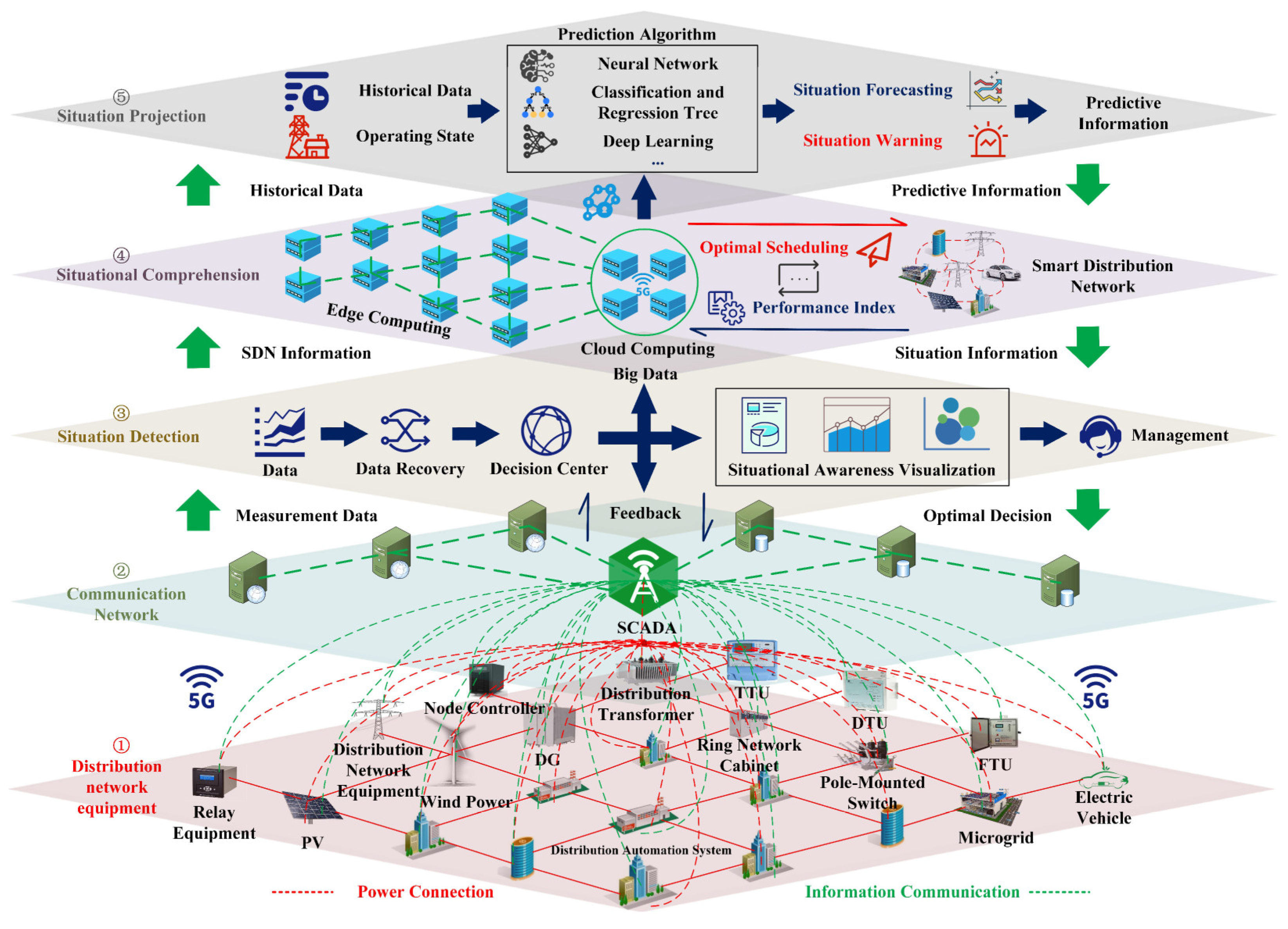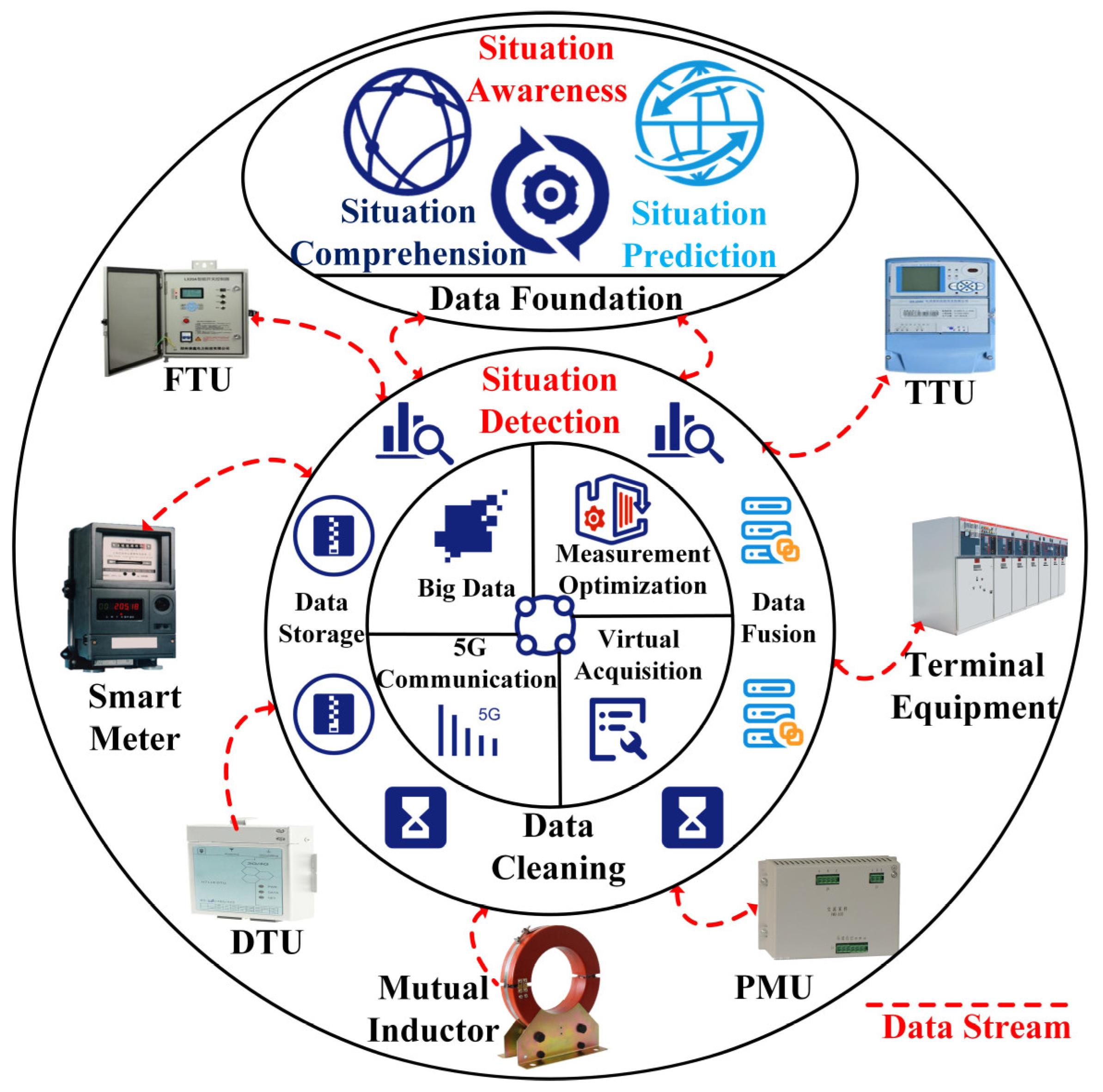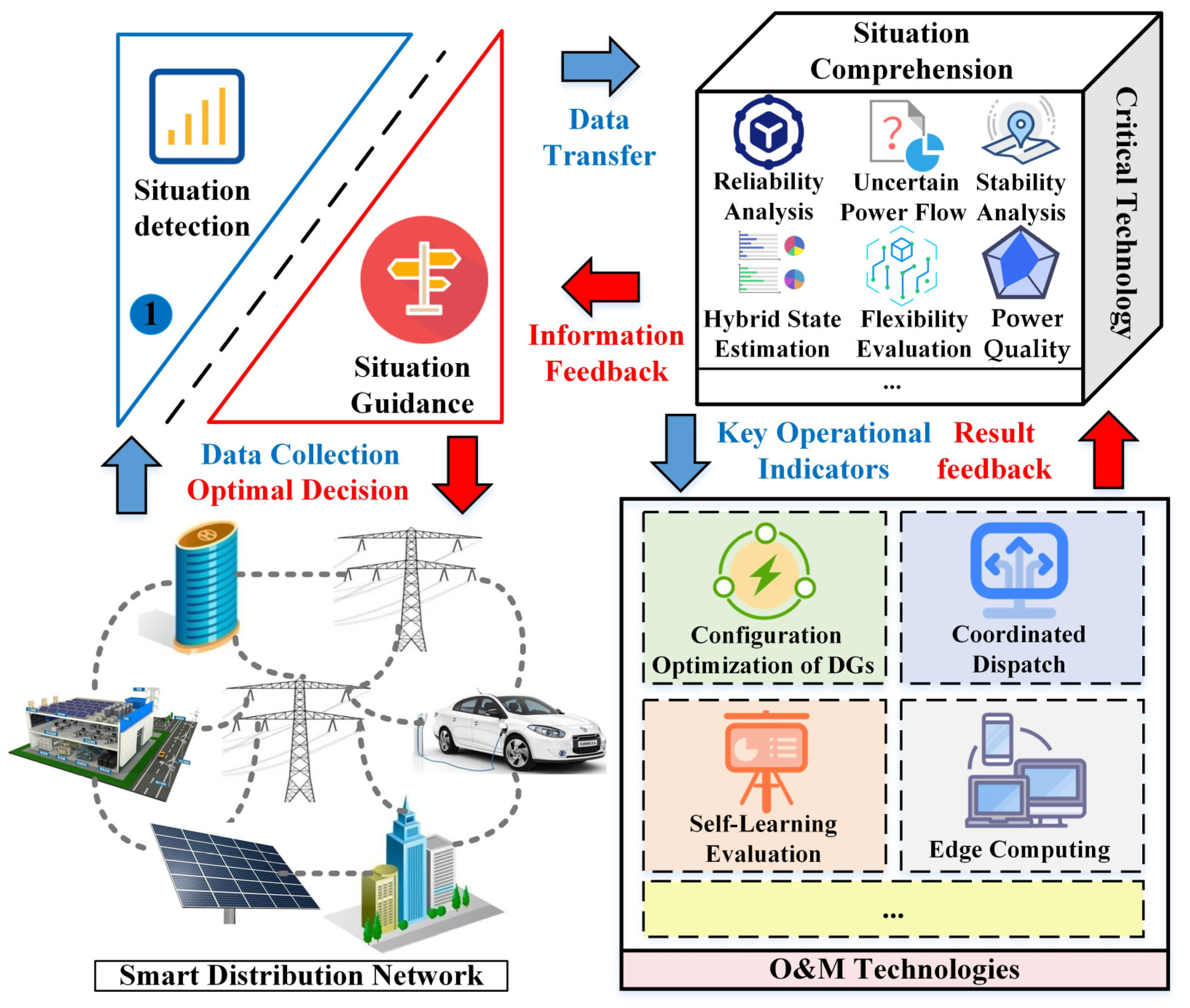
| Version | Summary | Created by | Modification | Content Size | Created at | Operation |
|---|---|---|---|---|---|---|
| 1 | Leijiao Ge | + 2905 word(s) | 2905 | 2022-02-11 04:07:09 | | | |
| 2 | Peter Tang | Meta information modification | 2905 | 2022-02-24 04:13:52 | | |
Video Upload Options
Due to the rapid development of emerging information and communication technologies (ICT) and advanced metering infrastructure (AMI), distribution networks are in an evolvement from passive to active distribution networks (ADN), also called smart distribution networks (SDN). Operation and maintenance (O&M) cost is an economic factor that the SDN management must consider. Among multiple O&M technologies, situation awareness (SA) emerges and is gradually integrated into the SDN. Facing a high proportion of RES, adequate monitoring, analysis, and prediction of the SDN operating status are urgent. Therefore, comprehensive SA, which contains detection, comprehension, and projection, becomes a significant guarantee for the optimal operation of SDN.
1. Introduction
- The sensation is the brain’s reflection of various attributes in objective things that directly act on the human sensory organs [14]. Human cognition of objective things starts with sensation. It is the initial detection of complex things and the basis of complex cognitive activities such as perception and behavior. That is similar to the concept of situation detection.
- Based on sensory information, perception processes multiple sensory information in a specific way, interprets the sensory information on individual experience, and taps the deep meaning of sensory information. That is similar to the concept of situation comprehension.
- Based on sensory and perception, behavior refers to human activities after receiving internal and external stimuli. The theory of planned behavior [15] can explain human decision-making behaviors from the perspective of perceptual information processing and predict the future behavioral tendency based on the expectation value theory [16]. That is similar to the concept of situation projection.
- Situation detection. The task of the stage is to detect essential features in the environment. Multi-dimensional data can be collected and completed in this stage. In addition, situation detection is the data basis of situation comprehension and projection.
- Situation comprehension. The essence of the stage is to understand the environment through data analysis. Specifically, the data obtained in the situation detection are integrated, and the connection and potential information between multi-source data are explored.
- Situation projection. The core of situation projection is to achieve the practical application of SA knowledge. Based on the information gained from situation detection and comprehension, this stage can predict the future environmental situation in time.
2. Description of Situation Awareness for Smart Distribution Networks
2.1. Objectives of Situation Awareness for Smart Distribution Networks
- The primary goal is to achieve real-time or quasi-real-time SA for SDN, which can accurately obtain the critical information of SDN, quickly determine the operating status of the distribution networks, and predict the development trend of SDN at the same time [11]. Based on the historical records of SDN data, SA provides a comprehensive SDN situation to ensure high-quality O&M.
- Observability is a significant technical indicator of SA. High-level SA can provide SDN with a highly visual situation and solve the shortcomings of insufficient measurement devices in the SDN [19].
- SA has a significant contribution to SDN reliability. Specifically, conduct the SDN self-healing technology, detect potential SDN risks, and predict security situations in advance. Finally, a scientific basis for the SDN active defense can be provided [13].
- Through continuous innovation of intelligent algorithms, SA is cultivating SDN self-adaptive capabilities [20]. Based on the information obtained by SA, SDN can independently recognize and improve the situation in an informed way.
2.2. Challenges of Situation Awareness for Smart Distribution Networks
- Situational detection challenges. New measurement technologies such as AMI [21] and phasor measurement units (PMUs) [22] are gradually deployed in SDN. Therefore, the data dimensions collected by SDN scale rapidly, which inevitably increases the computational pressure of SA. Due to the insufficient measurement devices, the collected data are challenging to recognize the poor operating status of the SDN. Therefore, the input data of the SA system are asymmetric, and some missing data are necessary to be accurately completed by calculation. How to comprehensively detect SDN status remains a challenging point in high-quality O&M.
- Situational comprehension challenges. Large-scale DGs lead the traditional dispatch mode to unsuitable. As a result, the phenomenon of reverse power transmission at the distribution network terminals is prominent, and the risk of voltage fluctuations and power loss increases [23]. In addition, different SDN topologies, operation modes, energy types, and automation levels have higher requirements for the compatibility of situational comprehension in different regions. Traditional situation comprehension technology is challenging to adapt to the current SDN. As the decision center of SDN, situation comprehension should assist the high-quality O&M of multi-form SDN. How to accurately understand the operating situation of the SDN is the focus of research.
- Situation projection challenges. Unlike passive distribution networks, SDN has a higher proportion of DGs and electric vehicles (EVs) and more diverse operating modes [24]. The uncertain outputs of DGs and EVs lead to an imbalance between power supply and consumption. Although the SDN flexibility is improved, the RES outputs, three-phase unbalanced load, EV charging, inspection schedule, and stability margin are challenging to determine in the situation projection. Additionally, situation projection for complex scenarios requires sufficient mathematical analysis, computational capability, and robustness capability. How to effectively predict the operational trend of SDN needs to be solved urgently.
3. Comprehensive Framework of Situation Awareness

4. Critical Technologies of Situation Detection

5. Critical Technologies of Situation Comprehension

6. Critical Technologies of Situation Projection

References
- Evangelopoulos, V.A.; Georgilakis, P.S.; Hatziargyriou, N.D. Optimal operation of smart distribution networks: A review of models, methods and future research. Electr. Power Syst. Res. 2016, 140, 95–106.
- Gill, S.; Kockar, I.; Ault, G.W. Dynamic Optimal Power Flow for Active Distribution Networks. IEEE Trans. Power Syst. 2014, 29, 121–131.
- Antoniadou-Plytaria, K.E.; Kouveliotis-Lysikatos, N.; Georgilakis, P.S.; Hatziargyriou, N.D. Distributed and Decentralized Voltage Control of Smart Distribution Networks: Models, Methods, and Future Research. IEEE Trans. Smart Grid 2017, 8, 2999–3008.
- Shicong, M.A.; Bingyin, X.U.; Houlei, G.A.O.; Yongduan, X.U.E.; Jinghua, W. An Earth Fault Locating Method in Feeder Automation System by Examining Correlation of Transient Zero Mode Currents. Autom. Electr. Power Syst. 2008, 32, 48–52.
- Ruj, S.; Nayak, A. A Decentralized Security Framework for Data Aggregation and Access Control in Smart Grids. IEEE Trans. Smart Grid 2013, 4, 196–205.
- Mansor, N.N.; Levi, V. Operational Planning of Distribution Networks Based on Utility Planning Concepts. IEEE Trans. Power Syst. 2019, 34, 2114–2127.
- Meng, F.Y.; Bai, Y.; Jin, J.L. An advanced real-time dispatching strategy for a distributed energy system based on the reinforcement learning algorithm. Renew. Energy 2021, 178, 13–24.
- Al Mhdawi, A.K.; Al-Raweshidy, H.S. A Smart Optimization of Fault Diagnosis in Electrical Grid Using Distributed Software-Defined IoT System. IEEE Syst. J. 2020, 14, 2780–2790.
- Lv, C.; Sheng, W.X.; Liu, K.Y.; Dong, X.Z.; Deng, P. Multi-status modelling and event simulation in smart distribution network based on finite state machine. IET Gener. Transm. Distrib. 2019, 13, 2846–2855.
- Kiaei, I.; Lotfifard, S. Fault Section Identification in Smart Distribution Systems Using Multi-Source Data Based on Fuzzy Petri Nets. IEEE Trans. Smart Grid 2020, 11, 74–83.
- Ge, L.; Li, Y.; Chen, Y.; Cui, Q.; Ma, C. Key Technologies of Situation Awareness and Implementation Effectiveness Evaluation in Smart Distribution Network. Gaodianya Jishu/High Volt. Eng. 2021, 47, 2269–2280.
- Yin, J.; Lampert, A.; Cameron, M.; Robinson, B.; Power, R. Using Social Media to Enhance Emergency Situation Awareness. IEEE Intell. Syst. 2012, 27, 52–59.
- Wang, S.; Liang, D.; Ge, L. Key Technologies of Situation Awareness and Orientation for Smart Distribution Systems. Autom. Electr. Power Syst. 2016, 40, 2–8.
- Dundes, A. On the psychology of legend. In American Folk Legend; University of California Press: Oakland, CA, USA, 2020; pp. 21–36.
- Lim, H.-R.; An, S. Intention to purchase wellbeing food among Korean consumers: An application of the Theory of Planned Behavior. Food Qual. Prefer. 2021, 88, 104101.
- Ajzen, I. The theory of planned behavior. Organ. Behav. Hum. Decis. Processes 1991, 50, 179–211.
- Luiza Neto, I.; Matsunaga, L.H.; Machado, C.C.; Gunther, H.; Hillesheim, D.; Pimentel, C.E.; Vargas, J.C.; D’Orsi, E. Psychological determinants of walking in a Brazilian sample: An application of the Theory of Planned Behavior. Transp. Res. Part F-Traffic Psychol. Behav. 2020, 73, 391–398.
- Ge, L.J.; Li, Y.L.; Li, S.X.; Zhu, J.B.; Yan, J. Evaluation of the situational awareness effects for smart distribution networks under the novel design of indicator framework and hybrid weighting method. Front. Energy 2021, 15, 143–158.
- Diez, D.; Romero, R.; Tena, S. Designing a Human Supervisory Control System for Smart Grid. IEEE Lat. Am. Trans. 2016, 14, 1899–1905.
- Ge, L.; Li, Y.; Yan, J.; Wang, Y.; Zhang, N. Short-term Load Prediction of Integrated Energy System with Wavelet Neural Network Model Based on Improved Particle Swarm Optimization and Chaos Optimization Algorithm. J. Mod. Power Syst. Clean Energy 2021, 9, 1490–1499.
- Choi, J.S.; Lee, S.; Chun, S.J. A Queueing Network Analysis of a Hierarchical Communication Architecture for Advanced Metering Infrastructure. IEEE Trans. Smart Grid 2021, 12, 4318–4326.
- De Oliveira-De Jesus, P.M.; Rodriguez, N.A.; Celeita, D.F.; Ramos, G.A. PMU-Based System State Estimation for Multigrounded Distribution Systems. IEEE Trans. Power Syst. 2021, 36, 1071–1081.
- Zhou, X.; Farivar, M.; Liu, Z.; Chen, L.; Low, S.H. Reverse and Forward Engineering of Local Voltage Control in Distribution Networks. IEEE Trans. Autom. Control 2021, 66, 1116–1128.
- Mohammadrezaee, R.; Ghaisari, J.; Yousefi, G.; Kamali, M. Dynamic State Estimation of Smart Distribution Grids Using Compressed Measurements. IEEE Trans. Smart Grid 2021, 12, 4535–4542.
- Taylor, Z.; Akhavan-Hejazi, H.; Cortez, E.; Alvarez, L.; Ula, S.; Barth, M.; Mohsenian-Rad, H. Customer-Side SCADA-Assisted Large Battery Operation Optimization for Distribution Feeder Peak Load Shaving. IEEE Trans. Smart Grid 2019, 10, 992–1004.
- Ye, J.; Ge, X.; Mao, G.; Zhong, Y. 5G Ultradense Networks With Nonuniform Distributed Users. IEEE Trans. Veh. Technol. 2018, 67, 2660–2670.
- Siirto, O.K.; Safdarian, A.; Lehtonen, M.; Fotuhi-Firuzabad, M. Optimal Distribution Network Automation Considering Earth Fault Events. IEEE Trans. Smart Grid 2015, 6, 1010–1018.
- Wang, N.; Zhao, F. An Assessment of the Condition of Distribution Network Equipment Based on Large Data Fuzzy Decision-Making. Energies 2020, 13, 197.
- Ding, D.; Han, Q.-L.; Ge, X.; Wang, J. Secure State Estimation and Control of Cyber-Physical Systems: A Survey. IEEE Trans. Syst. Man Cybern.-Syst. 2021, 51, 176–190.
- Ledva, G.S.; Mathieu, J.L. Separating Feeder Demand Into Components Using Substation, Feeder, and Smart Meter Measurements. IEEE Trans. Smart Grid 2020, 11, 3280–3290.
- Yang, X.; Gu, C.; Yan, X.; Li, F. Reliability-Based Probabilistic Network Pricing With Demand Uncertainty. IEEE Trans. Power Syst. 2020, 35, 3342–3352.
- Chen, S.; Li, P.; Ji, H.; Yu, H.; Yan, J.; Wu, J.; Wang, C. Operational flexibility of active distribution networks with the potential from data centers. Appl. Energy 2021, 293, 116935.
- Huang, W.; Zheng, W.; Hill, D.J. Distribution Network Reconfiguration for Short-Term Voltage Stability Enhancement: An Efficient Deep Learning Approach. IEEE Trans. Smart Grid 2021, 12, 5385–5395.
- DE Vasconcelos, F.M.; Santos Rocha, C.H.; Meschini Almeida, C.F.; Pereira, D.d.S.; Leite Rosa, L.H.; Kagan, N. Methodology for Inspection Scheduling in Power Distribution Networks Based on Power Quality Indexes. IEEE Trans. Power Deliv. 2021, 36, 1211–1221.
- Ge, L.; Li, Y.; Zhu, X.; Zhou, Y.; Wang, T.; Yan, J. An Evaluation System for HVDC Protection Systems by a Novel Indicator Framework and a Self-Learning Combination Method. IEEE Access 2020, 8, 152053–152070.
- Torbaghan, S.S.; Suryanarayana, G.; Hoschle, H.; D’Hulst, R.; Geth, F.; Caerts, C.; Van Hertem, D. Optimal Flexibility Dispatch Problem Using Second-Order Cone Relaxation of AC Power Flows. IEEE Trans. Power Syst. 2020, 35, 98–108.
- Mohseni, M.; Joorabian, M.; Ara, A.L. Distribution system reconfiguration in presence of Internet of things. IET Gener. Transm. Distrib. 2021, 15, 1290–1303.
- Gong, C.; Lin, F.; Gong, X.; Lu, Y. Intelligent Cooperative Edge Computing in Internet of Things. IEEE Internet Things J. 2020, 7, 9372–9382.
- Du, S.; Li, T.; Yang, Y.; Horng, S.-J. Deep Air Quality Forecasting Using Hybrid Deep Learning Framework. IEEE Trans. Knowl. Data Eng. 2021, 33, 2412–2424.
- Chen, L.; Li, M.; Su, W.; Wu, M.; Hirota, K.; Pedrycz, W. Adaptive Feature Selection-Based AdaBoost-KNN With Direct Optimization for Dynamic Emotion Recognition in HumanRobot Interaction. IEEE Trans. Emerg. Top. Comput. Intell. 2021, 5, 205–213.
- Azizivahed, A.; Arefi, A.; Ghavidel, S.; Shafie-khah, M.; Li, L.; Zhang, J.; Catalao, J.P.S. Energy Management Strategy in Dynamic Distribution Network Reconfiguration Considering Renewable Energy Resources and Storage. IEEE Trans. Sustain. Energy 2020, 11, 662–673.
- Viet Thang, T.; Islam, M.R.; Muttaqi, K.M.; Sutanto, D. An Efficient Energy Management Approach for a Solar-Powered EV Battery Charging Facility to Support Distribution Grids. IEEE Trans. Ind. Appl. 2019, 55, 6517–6526.
- Liang, J.; Jing, T.; Niu, H.; Wang, J. Two-Terminal Fault Location Method of Distribution Network Based on Adaptive Convolution Neural Network. IEEE Access 2020, 8, 54035–54043.
- Kong, W.; Ma, K.; Wu, Q. Three-Phase Power Imbalance Decomposition Into Systematic Imbalance and Random Imbalance. IEEE Trans. Power Syst. 2018, 33, 3001–3012.
- Xiao, J.; Zhang, B.; Luo, F. Distribution Network Security Situation Awareness Method Based on Security Distance. IEEE Access 2019, 7, 37855–37864.




